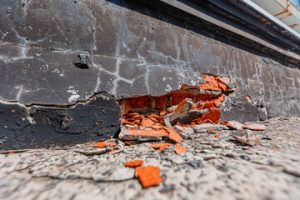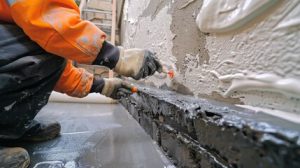Detecting foundation problems early can save you and your family from more expensive repairs down the road. Small cracks and leaks can grow into large issues if left unchecked.

Foundation Repair Murfreesboro TN restores functionality to your home – like keeping your doors open, or keeping you dry and pest-free. The process is a bit long but the results are worth it.
Foundation repair experts often recommend a variety of solutions, depending on the type and severity of cracks. Whether they are a result of natural settling or the underlying soil conditions in your area, cracks in the foundation can cause serious structural damage to your home. However, some cracks in the foundation can be repaired simply and inexpensively by a professional.
Cracks that are hairline in width usually don’t cause structural problems and can be filled with masonry caulk, which seals the crack and allows for expansion and contraction of the concrete without causing further damage. Cracks that are wider than a hairline can be fixed by using epoxy or another type of crack repair product. These products are available at most hardware stores. The products are applied with a caulking gun to fill the crack along its length. The crack should be brushed clean of dust, debris and dirt to allow the patch to adhere to the concrete. Before applying the caulking or epoxy, a hammer and chisel can be used to slightly widen the crack and “undercut” the edges of the crack. This gives the patch a better surface to adhere to.
Stair-step or horizontal cracks in a brick foundation can be caused by movement of the earth beneath the foundation or by moisture. They should be sealed and monitored for continued movement or a worsening of the cracks.
The most serious cracks are ones that continue to grow or are accompanied by bulging of the foundation walls. These should be evaluated by a professional as soon as possible to determine the root of the problem and what repair solution is best.
If your house is on a slab foundation, the most likely cause of these types of cracks is shifting in the soil underneath the slab. This can be caused by a number of reasons, including droughts, poor drainage and excessive rains. In these instances, a solution such as a french drain or concrete waterproofing may be needed to prevent further issues with the foundation and your home.
Underpinning
When the load on a building’s foundation is transferred to a deeper bearing layer, this can put a stop to settling and provide supplemental support. This is known as underpinning and is an effective remedy for a wide range of issues, including poor soil preparation during construction, settlement, soil creep, and erosion.
Underpinning involves extending a structure’s foundation into a deeper soil layer, usually with piers or concrete beams. It’s commonly used when a building is experiencing structural instability, or when new excavation work could negatively impact its existing foundation. Underpinning can also be used to improve the load-bearing capacity of a building in order to add extra floors that it wasn’t originally designed to accommodate.
There are many different types of underpinning, ranging from traditional mass concrete underpinning to more modern methods like micro-piling and jet grouting. Underpinning can be done to a variety of structures, from residential buildings to large industrial and commercial facilities. There are a few key signs that a foundation needs to be underpinned, including visible cracks in the walls and floors of a building. If these cracks are getting larger over time, this is a strong indication that there is a problem with the foundation. Uneven floors that are sunken, sloping or bowed can also indicate a problem with the foundation.
If you are experiencing any of these problems, it is important to contact a professional foundation contractor to evaluate the situation and recommend an appropriate underpinning method. In addition, a few preventative steps can help to keep your foundation in good condition and avoid underpinning or other damage:
Concrete Piers
Drilled concrete piers are a strong support system that anchors your foundation to stable layers of earth. They’re ideal for homes with expansive soil or heavy loads and offer a long-term solution to problems like foundation sinking, floor cracks, and buckling walls. They’re also a great choice for new construction projects that require deep support.
The key to successful concrete pier installation is having the right professional oversee the work. Look for a company with an outstanding reputation and plenty of customer reviews. Make sure the firm is insured and carries worker’s compensation and liability insurance. Ask about their warranty policy and whether they’re a member of any industry associations.
If you’re not happy with the contractor’s quote, don’t be afraid to get a second opinion. Most reputable professionals will be willing to provide free consultations and quotes, so you can compare prices and options. Don’t settle for the lowest price, though. You may end up paying more in the long run with subpar results or a repair that only fixes your current problem, but not the underlying issue.
Many pier-and-beam foundations experience structural issues due to improper construction or inadequate pier spacing. These problems can cause sagging floors, misaligned doors and windows, and other issues throughout the home. When a problem occurs, it’s important to address it immediately. This will prevent the situation from worsening and help save you money and time in the future.
Poor drainage around your foundation can lead to soil erosion, which can cause pier movement and weaken your foundation. A professional can recommend solutions such as a French drain or gutter extension to redirect water away from your foundation and keep it dry.
When the piers in your foundation start to shift, it’s important to get them inspected by a professional as soon as possible. If left unchecked, these shifts can damage the structural integrity of your home and lead to costly repairs down the road. A foundation inspection can identify these signs of trouble, including doors and windows that stick or won’t close properly, sagging floors, or visible shifting or sinking of the piers.
Steel Piers
The foundation is the base for the entire structure. It must be strong enough to support the weight of the building and protect it from failure and collapse. Often, a home’s foundation will need to be reinforced or replaced because the soil has changed or because the original foundation was built for less load-bearing materials than it is now.
If the signs of a failing foundation are present in your property, it is important to act quickly. These problems can lead to cracks in your walls, a floor that slants, and doors that don’t open properly. The sooner that you call a foundation repair company, the quicker your issues can be fixed and the longer your foundation will last.
One option for foundation repair is to use a pier system. These systems can include concrete, push, or helical steel piers. They work well for many situations, but there are a few factors to consider before deciding what type of pier is best for your situation.
Pressed concrete piers are a popular choice for foundation repair because they require minimal excavation and can be installed in relatively shallow soil. However, this type of pier is vulnerable to moisture swelling and can cause additional damage to your foundation over time. In addition, pressed concrete piers are not as strong as other types of piers.
In contrast, steel piers are highly resistant to soil movement and can be driven deep into the ground. They can be used in most soil conditions, including heavy clay. They are also more stable than concrete piers and can be used to lift and stabilize your foundation.
When it comes to choosing between helical and push steel piers, you should speak with a foundation repair expert. They will be able to help you decide which type of pier will serve your needs the best.
Once your piers have been installed, they will need to be tested to ensure that they are transferring the proper amount of weight to the soil. A professional will usually conduct this test by running a load machine over the foundation. After the testing is complete, a professional can then clean and restore the area around your foundation.
